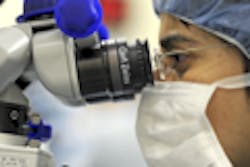Managing Mycoplasma genitalium infections during a rapid upsurge in antibiotic resistance
Mycoplasma genitalium is now an established cause of urethritis in men and pelvic inflammatory disease and cervicitis in women.1 While M. genitalium may not be as well understood as Neisseria gonorrhoeae and Chlamydia trachomatis, microbiology laboratories will soon be fielding more questions on this troublesome bacterium. This is because, unlike the other bacterial sexually transmitted infections (STIs) that remain sensitive to single-dose antibiotic therapy, M. genitalium infections in many countries are developing resistance to the antibiotics commonly deployed against them.2 The result is a growing number of infected patients with diminishing treatment options. This article reflects on lessons learned during a decade of managing M. genitalium at Melbourne Sexual Health Centre, a large public clinic in Australia’s second largest city. Clinical services around the world have been slow to adopt routine testing outside of research programs, largely because of the lack of commercially available assays for M. genitalium. When we began testing for M. genitalium in 2004, the test was limited to men with urethritis.3,4 Since then, testing has increased, as evidence of pathogenicity has strengthened, to include contacts of M. genitalium infection, women with pelvic inflammatory disease and cervicitis,5 and now proctitis.6
The therapeutic history
The long-acting macrolide, azithromycin, which remains an effective single-dose therapy for Chlamydia trachomatis infections, was initially also highly effective against M. genitalium. Early in vitro data suggested M. genitalium strains had minimum inhibitory concentrations (MICs) for most macrolides and tetracyclines within the susceptible range.7 But almost as soon as testing for M. genitalium began in Melbourne, some azithromycin failures occurred.8 A recent meta-analysis of studies of single-dose azithromycin treatment showed proportions of patients cured fell from 85 percent before 2009 to 67 percent after 2009.9 Doxycycline has not proved to be useful, with proportions cured in most studies falling below 40 percent.2
Resistance to macrolides is conferred by single nucleotide substitutions in domain V in the 23S ribosomal RNA gene. These macrolide resistance mutations (MRMs) have been identified by sequencing or by high-resolution melt analysis but can now be detected by one of the commercially developed diagnostic assays which uses a multiplex polymerase-chain reaction (PCR) for detection and resistance.10 MRMs are strong predictors of treatment failure (odds ratio 24 in one study).11 In papers published in 2016, they were present in 40 precent to 60 percent of infections from Canada,12 the United States,13 Australia,11 and Germany.14 It has also become clear that a proportion of macrolide-susceptible infections treated with single-dose azithromycin 1g will persist and develop detectable MRMs following treatment.
While the mechanism is unclear, it is likely that single-dose azithromycin, used alone or in combination for the treatment of urethritis and other STI syndromes, is selecting for macrolide resistance and contributing to the rising rates of MRM, and this may also be occurring even with higher dose and duration of azithromycin therapy.11,15
The major alternative to prescription of azithromycin is to use seven to 10 days of one of the broad-spectrum fluoroquinolone class of antibiotics, such as moxifloxacin or sitafloxacin, which are expensive and have uncommon but serious side effects.16 Resistance to fluoroquinolones is less common than to macrolides, and is rare in Northern Europe and the UK, but it is as high as 15 percent in STI services in Melbourne and Sydney.17,18 Until new antibiotic options become available, clinicians face a dilemma: prescribe a cheap, safe antibiotic (azithromycin) to which resistance is increasingly common and which may induce or select resistance, or a fluoroquinolone.
The U.S. Centers for Disease Control and Prevention guidelines, and the Australian guidelines, still recommend single-dose azithromycin as first-line treatment, while the European guidelines recommend 1.5g azithromycin over five days or josamycin over ten days.19,20
The U.S. and European guidelines recommend ten days of moxifloxacin for second-line therapy. With azithromycin resistance at or above 50 percent in many countries, some authors are recommending a reduction in the use of azithromycin as a treatment for STI, and this may be reflected in future guidelines.21
Testing and treatment
How best to approach the treatment dilemma will depend on what, if any, type of M. genitalium testing is available.
No testing available for M. genitalium: Culture is not available for M. genitalium diagnosis, as it takes months and is only available in a few laboratories globally. Several nucleic acid amplification tests are available, but none are yet approved by the U.S. Food and Drug Administration. In clinics without access to any M. genitalium testing, clinicians may still suspect the organism to be present in cases of chlamydia-negative non-gonococcal urethritis and pelvic inflammatory disease, with persistent symptoms after treatment. If azithromycin treatment has already failed, clinicians need to consider the risks and benefits of a fluoroquinolone in the absence of laboratory confirmation of infection.
Testing available for M. genitalium but not for macrolide resistance. Given the propensity for M. genitalium to develop MRMs after azithromycin treatment, a test of cure is essential. A positive test of cure always raises the possibility of non-adherence to therapy or of reinfection, but if these risks are considered low, then it can be assumed that MRMs are present whenever azithromycin has failed. There is no role for further azithromycin therapy in these cases, and moxifloxacin is the next option.
Combined testing for M. genitalium and macrolide resistance is available. These diagnostic tests identify infections that can be treated with azithromycin and those with MRMs that cannot. However, whenever a macrolide is used, the potential for generating further resistance is sufficiently high that clinics should do all they can to ensure that every patient returns for a test of cure.
Fluoroquinolones are contraindicated in a number of situations, including pregnancy and, as noted above, resistance is an emerging problem in the Asia-Pacific. In Melbourne we had some early success using oral pristinamycin dosed at 1g, four times daily for ten days, in cases where moxiflaxacin had failed or was contraindicated.17 Subsequently, we have observed a number of treatment failures, and these are the subject of current research.
Tests of cure should be performed three to four weeks after the start of treatment. In one study, all 16S PCR tests that were positive 14 days after treatment were also positive at 28 days, indicating there were no false positives at 14 days.17 The concern with early tests of cure, however, is that in some cases these have been negative for almost two weeks after treatment and then reverted to positive, suggesting that treatment suppressed the organism for a brief time without eliminating it.22 Therefore, the danger with early tests of cure between seven and 14 days after treatment appears to be one of false negatives rather than false positives.
First-pass urine is the ideal sample for M. genitalium detection in men; a rectal swab should also be added for homosexual men. In women, several comparative studies establish that M. genitalium is detected from a higher proportion of vaginal swabs than cervical swabs or urine samples.23-25
With azithromycin resistance at or above 50 percent in many countries, we need to review the place of this drug in STI management. Just as important, we need new antibiotics, or combinations of existing ones, and new diagnostic tools to keep up with this organism.
REFERENCES
- Taylor-Robinson D, Jensen JS. Mycoplasma genitalium: from chrysalis to multicolored butterfly. Clin Microbiol Rev. 2011;24(3):498-514.
- Jensen JS, Bradshaw C. Management of Mycoplasma genitalium infections–can we hit a moving target? BMC Infect Dis. 2015;15:343 doi:10.1186/s12879-015-1041-6.
- Bradshaw CS, Tabrizi SN, Read TR, et al. Etiologies of nongonococcal urethritis: bacteria, viruses, and the association with orogenital exposure. J Infect Dis. 2006;193:(3):336-345.
- Iser P, Read TH, Tabrizi S, et al. Symptoms of non-gonococcal urethritis in heterosexual men: a case control study. Sex Transm Infect. 2005;81:163-165. doi:10.1136/sti.2004.010751.
- Lis R, Rowhani-Rahbar A, Manhart LE. Mycoplasma genitalium infection and female reproductive tract disease: a meta-analysis. Clin Infect Dis. 2015; 61:(3):418-426.
- Bissessor M, Tabrizi SN, Bradshaw CS, et al. The contribution of Mycoplasma genitalium to the etiology of sexually acquired infectious proctitis in men who have sex with men. Clin Microbiol Infect. 2016;22:(3):260-265.
- Renaudin H, Tully JG, Bebear C. In vitro susceptibilities of Mycoplasma genitalium to antibiotics. Antimicrob Agents Chemother.1992;36:(4):870-872.
- Bradshaw CS, Jensen JS, Tabrizi SN, et al. Azithromycin failure in Mycoplasma genitalium urethritis. Emerg Infect Dis. 2006;12:(7):1149-1152.
- Lau A, Bradshaw CS, Lewis D, et al. The efficacy of azithromycin for the treatment of genital Mycoplasma genitalium: A Systematic Review and Meta-analysis. Clin Infect Dis. 2015;61:(9):1389-1399.
- Tabrizi SN, Tan LY, Walker S, et al. Multiplex assay for simultaneous detection of Mycoplasma genitalium and macrolide resistance using PlexZyme and PlexPrime technology. PLoS One. 2016;11:doi.org/10.1371/journal.pone.0156740.
- Read TRH, Fairley CK, Tabrizi S, et al. Azithromycin 1.5g over five days compared to 1g single dose in urethral Mycoplasma genitalium: impact on treatment outcome and resistance. Clinical Infectious Diseases. 2016;doi:10.1093/cid/ciw719.
- Gesink D, Racey CS, Seah C, et al. Mycoplasma genitalium in Toronto, Ont: estimates of prevalence and macrolide resistance. Can Fam Physician. 2016;62:(2):e96-e101.
- Getman D, Jiang A, O’Donnell M, Cohen S. Mycoplasma genitalium prevalence, coinfection, and macrolide antibiotic resistance frequency in a multicenter clinical study cohort in the United States. J Clin Microbiol. 2016;54:(9):2278-2283.
- Dumke R, Thurmer A, Jacobs E. Emergence of Mycoplasma genitalium strains showing mutations associated with macrolide and fluoroquinolone resistance in the region Dresden, Germany. Diagn Microbiol Infect Dis. 2016;86:(2):221-223.
- Jensen JS, Bradshaw CS, Tabrizi SN, et al. Azithromycin treatment failure in Mycoplasma genitalium-positive patients with nongonococcal urethritis is associated with induced macrolide resistance. Clin Infect Dis. 2008;47:(12):1546-1553.
- FDA updates warnings for oral and injectable fluoroquinolone antibiotics due to disabling side effects. FDA Drug Safety Communication. May 12, 2016; http://www.fda.gov/Drugs/DrugSafety/ucm511530.htm.
- Bissessor M, Tabrizi SN, Twin J, et al. Macrolide resistance and azithromycin failure in a Mycoplasma genitalium-infected cohort and response of azithromycin failures to alternative antibiotic regimens. Clin Infect Dis. 2015;60(8):1228-1236.
- Tagg KA, Jeoffreys NJ, Couldwell DL, et al. Fluoroquinolone and macrolide resistance-associated mutations in Mycoplasma genitalium. J Clin Microbiol. 2013;51(7):2245-2249.
- Horner PJ, Blee K, Falk L, et al. 2016 European guideline on the management of non-gonococcal urethritis. Int J STD AIDS. 2016;27(11):928-937.
- Workowski KA, Bolan GA. Sexually Transmitted Diseases Treatment Guidelines, 2015. Centers for Disease Control and Prevention Web site. http://www.cdc.gov/mmwr/preview/mmwrhtml/rr6403a1.htm.
- Horner P, Saunders J. Should azithromycin 1g be abandoned as a treatment for bacterial STIs? The case for and against. Sex Transm Infect. 2016; doi:10.1136/sextrans-2015-052414.
- Falk L, Enger M, Jensen JS. Time to eradication of Mycoplasma genitalium after antibiotic treatment in men and women. J Antimicrob Chemother. 2015;70 (11):3134-3140.
- Lillis RA, Nsuami MJ, Myers L, et al. Utility of urine, vaginal, cervical, and rectal specimens for detection of Mycoplasma genitalium in women. J Clin Microbiol. 2011;49(5):1990-1992.
- Munson E, Bykowski H, Munson KL, et al. Clinical laboratory assessment of Mycoplasma genitalium transcription-mediated amplification using primary female urogenital specimens. J Clin Microbiol. 2016;54(2):432-438.
- Wroblewski JK, Manhart LE, Dickey KA, et al. Comparison of transcription-
mediated amplification and PCR assay results for various genital specimen types for detection of Mycoplasma genitalium. J Clin Microbiol. 2006;44(9): 3306-3312.
Dr. Tim Read is sexual health physician at the Melbourne Sexual Health Centre, Alfred Health, Melbourne, Australia ,and NHMRC post-doctoral research fellow at Central Clinical School, Faculty of Medicine, Nursing and Health Sciences, Monash University, Melbourne, Australia.
Associate Professor Catriona Bradshaw is a sexual health physician at the Melbourne Sexual Health Centre and Central Clinical School, Faculty of Medicine, Nursing and Health Sciences, Monash University, Melbourne, Australia.

